One of the reasons consumers invest in an EV or hybrid vehicle is to achieve lower or zero emissions. Why, then, would they make that purchase only to power it using electricity generated from fossil fuel or nuclear power? From travelling 10,000km across ten countries in a homemade solar powered EV tuk tuk, to having a designer bamboo EV carport installed at home for domestic EV charging, OEMs, suppliers, and solar advocates are developing innovative ways of harnessing the power of the sun.
Solar powered tuk tuk
Over a beer, Naveen Rabelli scribbled down his idea on a paper napkin: converting a fuel-based tuk tuk to one that was powered by renewable energy sources. Now he plans to drive his self-built solar powered EV tuk tuk 10,000km (6,230 miles) from Bangalore, India to London, UK, visiting ten countries en route. Over 100 days, travelling around 100km a day, Rabelli’s Tejas (the Sanskrit word for radiance) Tuk Tuk will run on solar and electricity, producing zero emissions, to raise awareness of a potential sustainable, low-cost alternative transport solution. While the vehicle is just a concept at present, Rabelli told Megatrends he is open to discussing the possibility of production with an automotive design or manufacturing company. Rabelli said, “Tuk tuks are one of the most popular modes of public transport in India, yet they are noisy and air polluting. Our solar tuk tuk solution, if made widely available, will contribute to reducing these pollutants.”
Critics of EVs have said that given the current grid emissions in some countries, such as India, there is little to gain by switching to EVs. “As well as reducing air and noise pollution,” countered Rabelli, “we feel our tuk tuk will ease the pressure on the overburdened electricity systems in developing countries.” While a few years ago, it seemed unlikely that hybrid or EVs would reach the mass market, this changed through innovation, investment, government green agendas, and consumer education. “I believe this could drive the demand for solar powered vehicles,” he added.
If the solar powered EV tuk tuk did go into production, it is likely to have its biggest success in countries that already have huge numbers of conventional fuel tuk tuks, such as South and South East Asia. For now, Rabelli’s project, which has cost him US$6,000, will help further the study of alternative mobility solutions, showcase an entirely Indian solution to the world, practically demonstrate his prototype, and help Rabelli connect with others working towards sustainable living solutions. Currently the vehicle can travel 80km (50miles) when charged for eight hours. With five hours of exposure to the sun, it can go for another 25km (16miles).
BMW solar powered bamboo EV carport
If an EV driver is looking to charge their car in style, BMW has revealed a solar powered bamboo carport to charge the i8 and i3, which recently arrived in the US. The i Solar Carport, designed by BMW Group DesignWorks USA, takes style notes from the i3 and i8 EVs. The carport is made out of renewable bamboo, with its roof covered in translucent high-grade glass-on-glass solar modules that send electricity to the EVs, via BMW’s i Wallbox Pro. Once an EV is fully charged, independent of grid-based electricity, any surplus power can be redirected for domestic use.

Although there are no official plans to produce the i Solar Carport yet, Tom Allemann, BMW DesignWorks USA said, “With the solar carport concept we opted for a holistic approach: not only is the vehicle itself sustainable, but so is its energy supply. This is therefore an entirely new generation of carports that allows energy to be produced in a simple and transparent way. It renders the overarching theme of lightweight design both visible and palpable.”
Solar powered Golf EV
While BMW has revealed its concept for private EV home charging, Volkswagen already offers e-Golf drivers in the US the possibility of installing a SunPower solar system to help with home recharging, through a partnership with SunPower. The supplier says this will help customers save on annual household electricity bills, while powering their EVs, which in turn helps reduce the overall cost of ownership.
Even if a power outage occurred, owners would be able to access back-up power to charge their EVs. Tom Werner, President and Chief Executive, SunPower, said, “Investing in a residential SunPower solar system is a reliable, cost-effective way for Volkswagen customers to help manage household electricity costs and charge their electric vehicle with emissions-free energy.”
Solar powered world record
As well as charging EVs, solar power can also be used to power vehicles. Students from the University of New South Wales in Australia have created the world’s fastest long-range solar powered EV: the Sunswift eVe. On a single battery charge, the eVe averaged speeds of 62mph for 310 miles, ten miles more than the 300 mile official range of the Tesla Model S, although it is considerably lighter at 700 pounds (317.5kg). By the end of 2014, the students are hoping to make the vehicle the first road-legal solar powered vehicle, and are encouraging OEMs to invest in more research on EV technology.
Hayden Smith, Project Director for Sunswift said the vehicle highlights that solar powered EVs are a “viable alternative to conventional fossil fuel-powered vehicles.” As range still remains a huge issue for EVs, the students also wanted to show that it is possible for EVs to have significantly extended ranges. The solar panels are fitted to the vehicle’s body, and have the potential to charge while driving, offering enough energy to power two hours of driving. To achieve a full charge via a household wall-socket, the vehicle requires eight hours, but rapid charging units could also be used to reduce charge time.
Ford’s solar powered plug-in hybrid
 There may be no indication of a commercial launch for Ford’s C-MAX Solar Energi Concept, which was demonstrated at the 2014 International CES, but the vehicle highlighted the possibility of combining solar power, electrification, and autonomous drive technology. The vehicle is equipped with three SunPower-developed high-efficiency solar cells on the roof, each capable of generating just over 100 watts. Over the course of a day in the sun, this is sufficient to generate about one-eighth of the car’s battery charge, explained Mike Tinskey, Global Director of Vehicle Electrification and Infrastructure at Ford Motor Company. “We’re excited about starting the conversation about how all these technologies – autonomous car, solar power and vehicle electrification – are starting to converge, and this is an example of what you can do when you leverage that,” said Tinskey. Ford has estimated that if all light-duty vehicles in the US adopted the Ford C-MAX Solar Energi Concept, greenhouse gas emissions could be reduced by around 1 billion metric tons a year.
There may be no indication of a commercial launch for Ford’s C-MAX Solar Energi Concept, which was demonstrated at the 2014 International CES, but the vehicle highlighted the possibility of combining solar power, electrification, and autonomous drive technology. The vehicle is equipped with three SunPower-developed high-efficiency solar cells on the roof, each capable of generating just over 100 watts. Over the course of a day in the sun, this is sufficient to generate about one-eighth of the car’s battery charge, explained Mike Tinskey, Global Director of Vehicle Electrification and Infrastructure at Ford Motor Company. “We’re excited about starting the conversation about how all these technologies – autonomous car, solar power and vehicle electrification – are starting to converge, and this is an example of what you can do when you leverage that,” said Tinskey. Ford has estimated that if all light-duty vehicles in the US adopted the Ford C-MAX Solar Energi Concept, greenhouse gas emissions could be reduced by around 1 billion metric tons a year.
By combining solar power with electrification, OEMs and suppliers are opening up a new world of possibilities, from ‘free’ charging keeping EVs off the electricity grid, to vastly extending the range of EVs past the dizzying heights of the Tesla Model S. While many ideas are currently in the concept or prototype stage, EVs of the future really could be powered by the sun.



